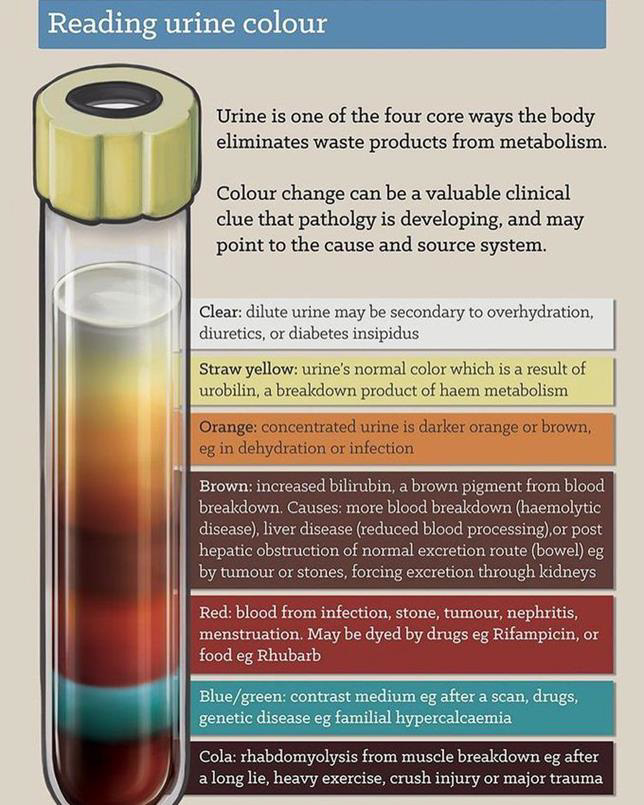Joseph R. Anticaglia MD
Medical Advisory Board
The kidneys make urine when they filter your blood. Water makes up 95% of urine. The other 5% consists of materials such as creatinine, urea, ammonia and the ions of sodium, calcium and potassium. This ratio is noteworthy because too much or too little water, plus other factors, affect the color of your urine. What are the different colors of the urine? What do they mean? When should I see my doctor?
A Peek at Pee — Your Urine Colors
We’ve all been in a doctor’s office when a nurse hands us a cup and says: “The doctor wants a sample of your urine.” We routinely provide the sample and wait for the results after we leave the office. At home, we usually don’t pay attention to the color of the urine, but certain urine colors demand a consultation with your physician.
Urine Colors
1) Clear/Transparent
You’re overhydrated. It’s rare, but drinking too much water can cause electrolyte imbalance. Also, diuretics, and diabetes insipidus can lead to colorless urine.
2) Yellow
The normal color of urine goes from pale yellow to amber. Aim for light, straw colored urine. Urochrome is the chemical pigment that causes the yellow color in the urine. It’s the breakdown product of hemoglobulin and is removed by the kidneys.
2A — Amber
When the urine becomes honey colored or deep amber (midway between yellow and orange) the body is telling you to drink more water.
3) Orange
This colored urine can be the byproduct of beta-carotene in the foods we eat, such as carrots or sweet potatoes. In addition, certain medications can cause the urine to turn orange; for instance, Pyridium prescribed for patients with pain on urination, and the anti-inflammatory drug Azulfidine. Also, orange urine may indicate a problem with your liver or bile duct.
4) Brown or Cola Urine
Liver (cirrhosis, hepatitis, tumors), kidney disease (kidney stones, post-streptococcus kidney infection) and porphyria can result in brown urine. Drugs can cause the urine to turn brown, including Flagyl and Furadantin. Foods, such as eating large amounts of fava beans or rhubarb can turn the urine dark brown. Extreme exercise can damage the kidneys causing pink or brown colored urine. See your doctor if it persists.

5) Red or Pink Urine
Red or pink urine might indicate blood in the urine (hematuria) and is a reason to see your doctor. Medical conditions that range from urinary tract infections and kidney stones to tumors can turn the urine red. However, beets, blackberries and rhubarb can also cause red urine. Medications such as Rifampicin used to treat tuberculosis or Pyridium can turn the urine red.
If you have done heavy exercises or long distance running, you may experience reddish-brown blood in the urine because of the breakdown of muscle fibers (rhabdomyolysis). Make arrangements to see your doctor.
6) Green or Blue Urine
The above color is usually benign, but it could be a sign of a bacterial infection. Asparagus and a number of medications can turn the urine blue or green e. g., indomethacin, the dye methylene blue, and amitriptyline.
7) Cloudy Urine
Cloudy urine can range from dehydration to urinary tract infections, kidney stones or sexually transmitted diseases. Call your doctor for the above or if you are pregnant, immunosuppressive or have pain or abdominal discomfort.
8) Foamy Urine
Most often it’s caused by a strong urinary stream. If it persists, call your doctor to rule out kidney or bladder disease.
Normal urine goes from pale yellow to dark amber, but it can present with a variety of colors. The more water you drink, the clearer the urine appears and vice versa. Food, medicines, medical conditions, exercise, artificial colors, dyes used in medicine and fluid intake can influence the color of your urine.
Knowing the changes in the color in your urine caused by foods, medicines or fluid intake can save you from anxiety. It only takes seconds to “peek at your pee.” Consult your physician if there’s blood in the urine, has a dark-brown color or if you have an abnormal urine color that persists.
References
- Urology Care Foundation; The Meaning Behind the Color of Urine; American Urological Association, Aug. 22, 2018
- Daniel A. Queremel Milani; Ishwarlal Jialal. Urinalysis; StatPearls, May 8, 2022
- What Your urine Says About Your Health; #Deep Dives, 2021
Glossary
Phenazopyridine (Pyridium)
Sulfasalazine (Azulfidine)
Metronidazole (Flagyl) and
Nitrofurantoin (Furadantin)
This article is intended solely as a learning experience. Please consult your physician for diagnostic and treatment options.

